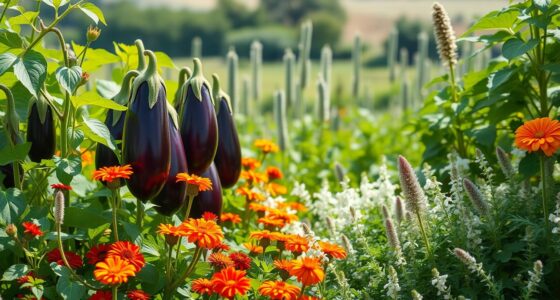A companion planting chart is your quick guide to boosting garden health and yields naturally. It shows which plants grow well together, helps you avoid pairing incompatible crops, and suggests flowers and herbs that attract pollinators and repel pests. By planning strategically, using beneficial combinations, and rotating crops, you can create a balanced, productive garden. Keep exploring to discover more tips on designing and maintaining a thriving garden environment.
Key Takeaways
- Provides plant pairings that promote growth, repel pests, and enhance soil health for better garden productivity.
- Highlights beneficial insect attractors like flowers and herbs to support natural pest control.
- Lists plants to avoid pairing due to competition or shared pests, aiding strategic planning.
- Emphasizes crop rotation, spacing, and location considerations to prevent disease and maximize sunlight.
- Includes tips on using herbs and cover crops to improve soil fertility and attract beneficial insects.
Benefits of Companion Planting
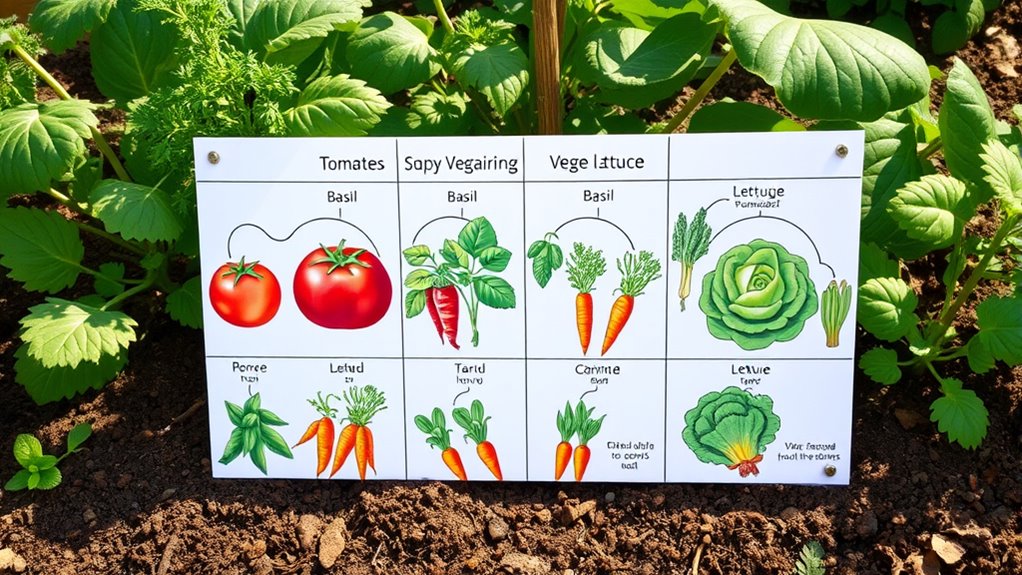
Companion planting offers several practical benefits that can improve your garden’s health and productivity. When you plant certain vegetables together, they can naturally repel pests, reducing the need for chemical pesticides. For example, marigolds can deter nematodes and aphids, protecting nearby crops. Additionally, some plants enhance nutrient uptake for their neighbors; legumes, like beans, fix nitrogen in the soil, benefitting surrounding plants. Understanding plant compatibility can help you make the most effective pairings for your garden’s success. Companion planting also encourages biodiversity, which can support beneficial insects that help control pests. It can even improve flavor and crop yields by creating a balanced environment. By thoughtfully pairing your plants, you create a more resilient garden that requires fewer interventions. Maximize space and organization This approach not only saves you time and effort but also promotes a healthier, more sustainable gardening experience. Furthermore, incorporating soil health practices through companion planting can lead to long-term improvements in your garden’s vitality. Recognizing how plant interactions influence overall growth can help you develop a more productive and resilient garden system.
Vegetables That Grow Well Together
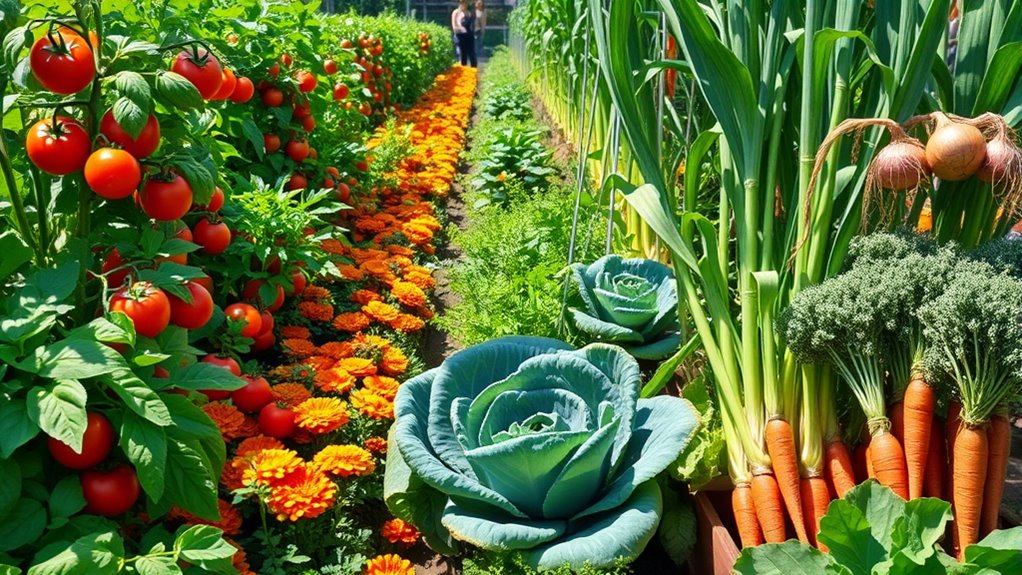
Planting compatible vegetables together can especially boost your garden’s productivity and health. When you choose the right pairings, vegetables can support each other’s growth and ward off pests naturally. For example, tomatoes thrive alongside basil, which can improve flavor and repel pests. Carrots grow well with onions, helping to deter carrot flies. To visualize effective pairings, consider this table:
| Vegetables | Compatible Partners |
|---|---|
| Tomatoes | Basil, carrots, onions |
| Carrots | Onions, leeks |
| Beans | Corn, cucumbers |
Using this guide, you’ll enhance your garden’s yield while reducing the need for chemicals. Focus on combinations that promote healthy growth and natural pest control for a thriving vegetable garden. Understanding companion planting can further optimize your gardening success, especially since pest management strategies play a key role in maintaining plant health. Additionally, incorporating knowledge about the history of gardening practices can provide valuable insights into effective crop pairing techniques.
Plants to Avoid Pairing

While certain vegetables can thrive together, others can hinder each other’s growth or attract unwanted pests, so it’s important to know which plants to avoid pairing. For example, don’t plant tomatoes near brassicas like cabbage or broccoli, as they can compete for nutrients and increase pest problems. Avoid planting beans next to onions or garlic, since these can inhibit each other’s growth. Corn and potatoes should also be kept apart; they’re prone to sharing pests like the potato beetle. Additionally, fennel tends to repel many plants and can interfere with nearby growth, so keep it separate. Understanding plant compatibility can help you make better pairing choices. Recognizing interplant relationships can further optimize your garden’s health and productivity. Being aware of disease prevention strategies can also reduce the likelihood of common garden ailments. By understanding these pairings to avoid, you reduce the risk of pests, diseases, and poor yields, helping your garden stay healthy and productive.
Herbs That Enhance Garden Health
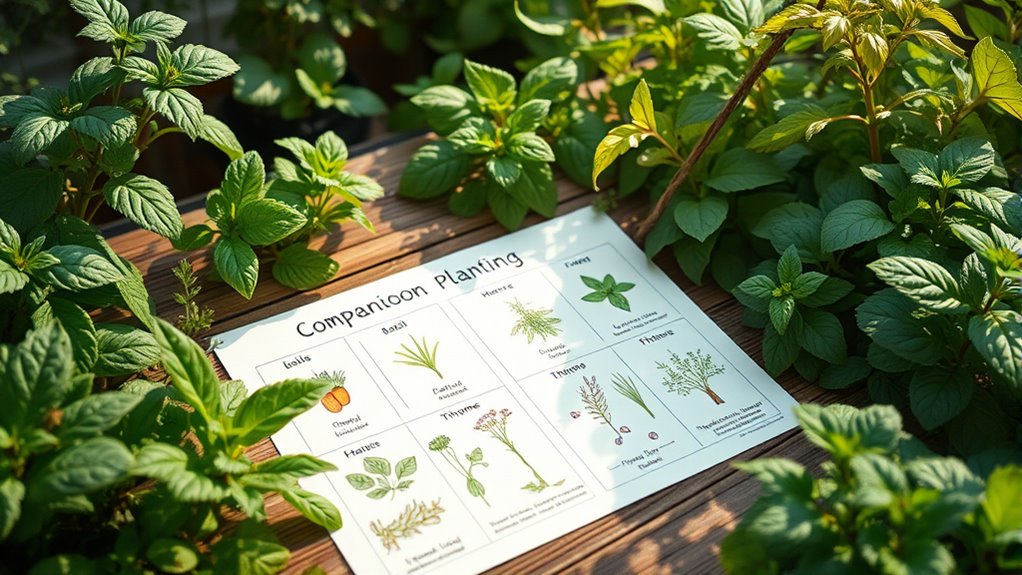
Herbs like basil and mint can help keep pests away naturally, protecting your garden without chemicals. They also improve soil health by adding nutrients or preventing soil depletion. Incorporating these herbs boosts your garden’s overall cruciality and resilience. Additionally, planting water-efficient herbs can further conserve resources while maintaining a healthy garden. As automation and innovative technologies advance, integrating sustainable gardening practices can further enhance your garden’s productivity and ecological balance. Understanding environmental impacts helps in selecting the most eco-friendly gardening methods for long-term sustainability. Embracing native plants can also promote a more resilient and thriving garden ecosystem.
Pest Deterrent Properties
Many herbs naturally repel pests, making them valuable allies in maintaining a healthy garden. For example, basil deters mosquitoes and flies, while mint keeps away ants and aphids. Marigolds, often classified as herbs, emit a scent that confuses nematodes and beetles, protecting nearby plants. Rosemary and thyme also repel certain insects, such as cabbage moths and beetles, reducing the need for chemical controls. Incorporating these herbs strategically around your garden can create a natural barrier against pests, promoting healthier plants and better yields. Additionally, meditation practices can help gardeners reduce stress and enhance their connection with nature, leading to more mindful gardening experiences. The use of Glycolic Acid in skincare demonstrates the importance of natural and effective solutions for skin health. Keep in mind that the effectiveness varies depending on the pest and environment. Incorporating pest-repellent herbs into your planting plan offers a sustainable, chemical-free way to safeguard your garden’s health.
Soil Enrichment Benefits
Incorporating certain herbs into your garden can substantially improve soil health by enriching its nutrients and structure. Herbs like basil, chives, and oregano release beneficial compounds that enhance soil quality over time. For example, chives contain sulfur compounds that can help suppress soil-borne diseases, while basil attracts pollinators and beneficial insects that support overall plant health. These herbs also add organic matter when they decompose, improving soil fertility and drainage. Additionally, their deep roots can break up compacted soil, increasing aeration. Planting herbs with these qualities not only benefits the herbs themselves but also creates a healthier environment for your vegetables and flowers. Moreover, selecting soil-enriching plants can help mitigate vulnerabilities to pests and diseases, contributing to a more resilient garden ecosystem. By intentionally choosing herbs for soil enrichment, you foster a more resilient and productive garden ecosystem.
Flower and Vegetable Combinations

Pairing flowers with vegetables can boost your garden’s productivity and attract beneficial insects. When you choose the right combinations, you not only enhance visual appeal but also create a balanced ecosystem. Flowers like marigolds and nasturtiums can deter pests while attracting pollinators that help your vegetables thrive. Consider planting sweet alyssum near tomatoes or basil with peppers to improve flavor and health. These pairings support natural pest control, improve pollination, and maximize space use. Incorporating sustainable gardening practices into your routine can also foster a deeper connection to the land and promote sustainable, holistic growth. Using raw food principles such as preserving natural nutrients can inspire eco-friendly gardening approaches that maintain soil health and biodiversity. Understanding how self watering plant pots work can help you better care for your plants and optimize their growth in your sustainable garden.
Attracting Beneficial Insects
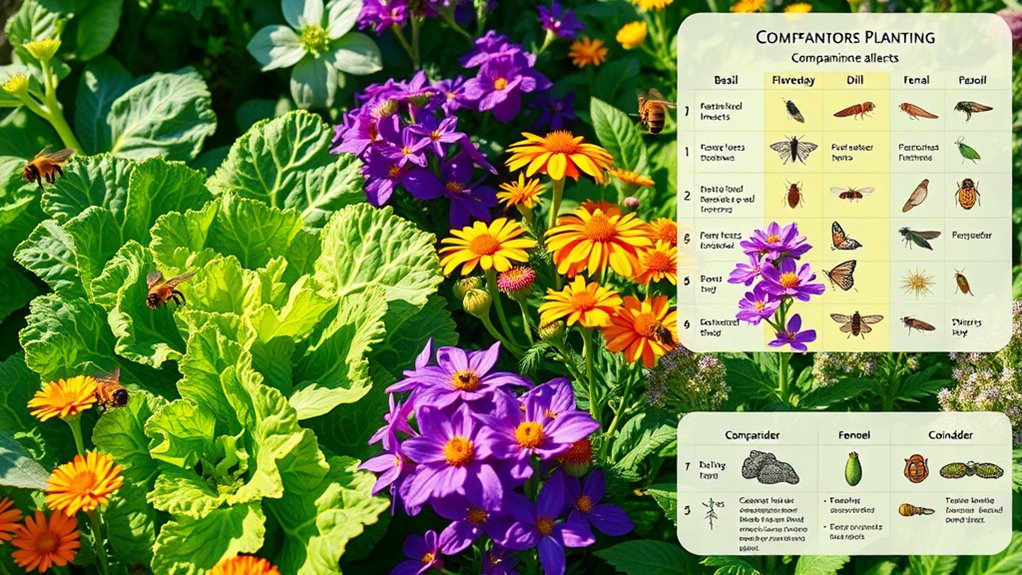
You can attract beneficial insects by planting pest-repellent varieties and nectar-rich flowers that lure bees. These plants not only protect your crops but also support healthy pollinator populations. Choosing the right companion plants encourages natural predators to stay and keep pests in check. Incorporating beneficial insect attraction techniques can further enhance your garden’s natural pest control. Additionally, selecting plants with robust warranties and compact designs can help ensure your garden tools are reliable for ongoing maintenance. Incorporating cultural and regional breakfasts into your garden planning can also inspire creative planting choices that attract diverse beneficial insects.
Plant Pest Repellents
Attracting beneficial insects is an effective way to naturally protect your garden from pests. By using specific plants as pest repellents, you can create a barrier that deters harmful insects while encouraging helpful ones. Incorporate plants like marigolds, basil, mint, and garlic, which emit scents that repel pests such as aphids, beetles, and nematodes. These plants not only act as natural repellents but also improve soil health and attract pollinators. To maximize their effectiveness, plant them near vulnerable crops or along garden borders. Remember, a diverse garden attracts a variety of beneficial insects, creating a balanced ecosystem that reduces pest populations without chemicals. This strategy promotes healthier plants and a more sustainable garden environment overall.
Nectar Sources for Bees
Beneficial insects like bees play a vital role in pollinating your garden and boosting plant health. To attract these helpful visitors, incorporate plants that provide abundant nectar sources. Flowers such as lavender, bee balm, sunflowers, and coneflowers are excellent choices because they produce plentiful nectar and are attractive to bees. Plant a variety of these blooms throughout your garden to guarantee a continuous supply of nectar from early spring to late fall. Avoid using pesticides that can harm bees, and consider planting in clusters to make it easier for pollinators to locate the nectar. By providing a diverse range of nectar-rich plants, you’ll encourage bees to visit regularly, increasing pollination success and supporting a thriving, productive garden.
Companion Plants for Predators
Incorporating specific plants into your garden can naturally draw in predators like ladybugs, lacewings, and predatory beetles that keep pest populations in check. These beneficial insects help reduce the need for chemical pesticides and promote a healthy ecosystem. To attract them, plant flowers and herbs that serve as food sources and habitat. For example, dill, fennel, yarrow, and marigolds are excellent choices. These plants provide nectar, pollen, and shelter, encouraging predators to stay and hunt pests. By fostering these natural allies, you create a balanced environment where pests are controlled organically. Incorporate diverse, flowering plants to sustain predator populations year-round. This approach enhances your garden’s resilience, reduces pest issues, and promotes thriving, healthy plants.
Improving Soil Fertility Naturally
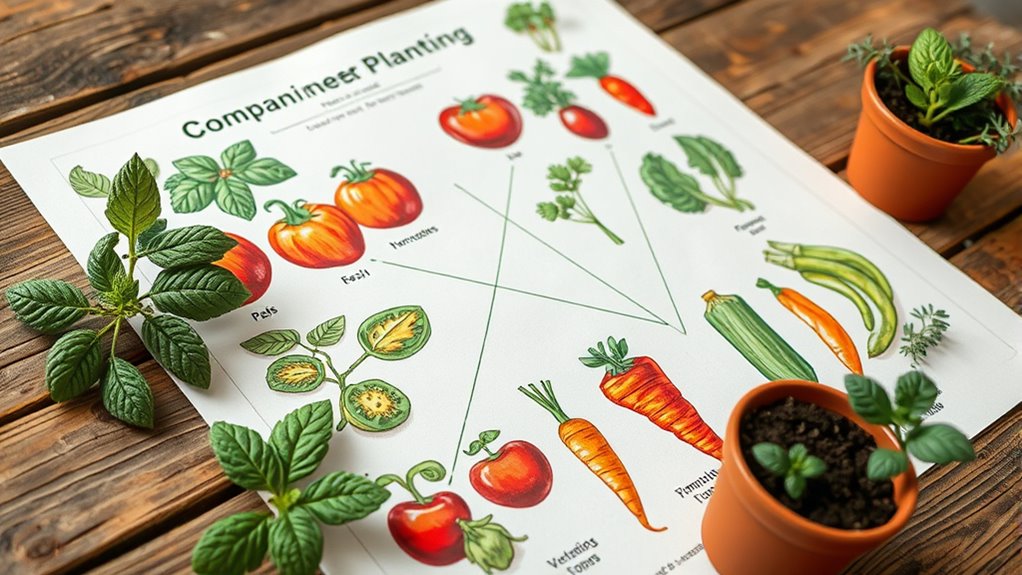
To improve soil fertility naturally, you can focus on practices that enrich the soil without synthetic chemicals. Incorporate compost regularly to add organic matter and essential nutrients. Using cover crops like clover or vetch helps fix nitrogen in the soil, boosting fertility for future planting seasons. Mulching with organic materials such as straw or leaves prevents erosion and maintains moisture, promoting healthy microbial activity. Avoid synthetic fertilizers that can disrupt soil balance; instead, opt for natural amendments like aged manure or bone meal. Practice crop rotation to reduce nutrient depletion and prevent soil exhaustion. These methods build healthy, resilient soil, supporting strong plant growth and reducing the need for chemical inputs over time.
Companion Planting for Pest Control

You can reduce pests naturally by choosing plants that act as repellents or attract beneficial insects. These companion plants help keep pests away and encourage helpful bugs to stay in your garden. Incorporating them into your planting scheme boosts pest control without chemicals.
Natural Pest Deterrents
Natural pest deterrents are a key benefit of companion planting, as certain plants release scents or chemicals that repel harmful insects. These plants act as natural repellents, reducing the need for chemical pesticides. By strategically placing these deterrents around your garden, you create a protective barrier that keeps pests at bay. For example, aromatic herbs and strong-smelling flowers can confuse or deter insects from settling on your crops. Incorporating these plants not only safeguards your harvest but also promotes a healthier garden environment.
- Herbs like basil and mint mask the scent of vegetables, confusing pests.
- Marigolds emit chemicals that deter nematodes and beetles.
- Nasturtiums repel aphids and whiteflies.
- Chrysanthemums contain pyrethrum, a natural insecticide.
Beneficial Insects Attraction
Attracting beneficial insects is a powerful way to naturally control pests in your garden. By planting specific flowers and herbs, you invite helpful insects like ladybugs, lacewings, and parasitic wasps that prey on common pests. Marigolds, dill, fennel, and yarrow are excellent choices because they produce nectar and pollen that attract these beneficial insects. Keep in mind, providing continuous blooms ensures a steady supply of food, encouraging beneficial insects to stay and protect your plants. Avoid broad-spectrum insecticides, which can harm these helpful allies. Instead, focus on diverse plantings that create a welcoming habitat. With intentional companion planting, you can reduce pest populations naturally and promote a healthier, more balanced garden ecosystem.
Designing Your Garden Layout
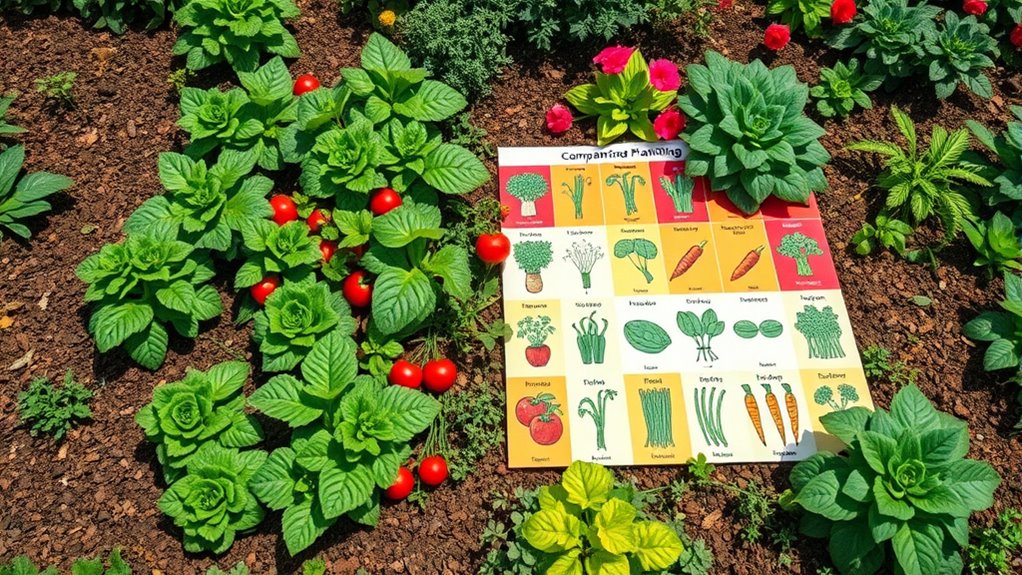
Designing your garden layout begins with understanding how different plants interact and influence each other. You want to arrange plants thoughtfully to maximize benefits like pest control, nutrient sharing, and growth support. Consider plant placement based on their compatibility and growth habits to prevent competition and promote healthy development. Think about sunlight, spacing, and airflow to reduce disease risk and encourage vigorous growth. Group plants with similar needs together to simplify maintenance and watering routines. Also, position taller plants where they won’t overshadow smaller ones, ensuring all receive adequate light.
- Group compatible plants for mutual benefits
- Space plants to improve air circulation
- Place taller plants where they won’t block sunlight
- Plan for easy access for watering and harvesting
Tips for Successful Companion Planting
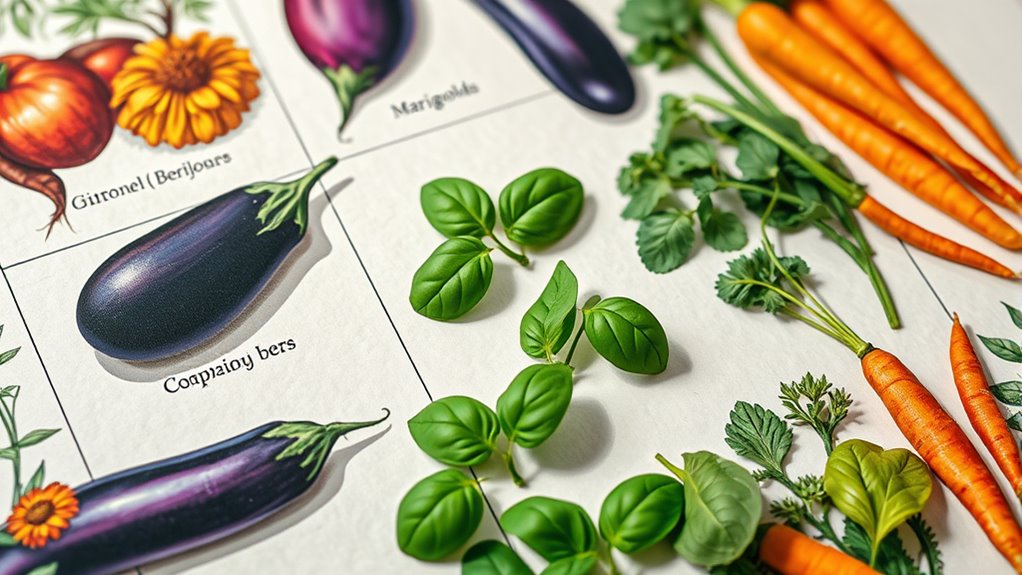
To guarantee your companion planting efforts succeed, you need to apply some practical tips that maximize the benefits of plant interactions. First, research which plants naturally complement each other’s growth habits and pest resistance. Group compatible plants together, like tomatoes with basil or carrots with onions, to enhance growth and deter pests. Pay attention to spacing; overcrowding can hinder air circulation and increase disease risk. Rotate crops annually to prevent soil depletion and pest buildup. Keep the soil healthy by adding compost and mulch to retain moisture and suppress weeds. Regularly monitor your garden for signs of pests or disease, and adjust plant pairings if necessary. With careful planning and observation, you’ll create a thriving garden that benefits from natural plant partnerships.
Frequently Asked Questions
How Do I Start a Companion Planting Chart From Scratch?
To start a companion planting chart from scratch, first list your garden’s vegetables, herbs, and flowers. Research which plants benefit each other and note their compatibility. Use a notebook or digital tool to map out your garden beds, pairing plants that support growth or deter pests. Keep updating your chart as you learn. This approach helps maximize yields, reduce pests, and create a thriving, balanced garden.
Can Companion Planting Be Effective in Small Urban Gardens?
Think of your small urban garden as a bustling city block—every plant needs its neighbor to thrive. You can absolutely make companion planting work there; it’s like fitting puzzle pieces together. Use vertical space for climbing plants, and choose companions that boost each other’s growth or repel pests. With careful planning, you’ll turn your tiny plot into a thriving oasis, full of harmony and productivity.
How Long Does It Take to See Results From Companion Planting?
You’ll notice results from companion planting within a few weeks to a couple of months, depending on the plants involved. Fast-growing crops like lettuce or radishes show quick benefits, while slower-growing plants may take longer to see improvements. Keep observing your garden regularly, and you’ll start to notice healthier plants, fewer pests, and better yields as the beneficial relationships develop over time.
Are There Any Common Mistakes to Avoid in Companion Planting?
When you’re practicing companion planting, avoid common mistakes like overcrowding your plants, which can hinder growth and air circulation. Don’t ignore the specific needs of each plant, such as sunlight and water requirements, as mismatched pairs won’t thrive together. Also, skip planting incompatible species side by side, and neglect to plan for crop rotation to prevent soil depletion. These steps help ensure healthier plants and better yields.
How Do I Adapt Companion Planting for Different Climate Zones?
Adapting your planting practices for diverse climate zones can be formidable, but you can do it with diligent research and local insights. You should select species suited to your zone, considering temperature, rainfall, and soil. While tweaking timing, you might test different pairings and observe outcomes. By paying close attention to local conditions, you’ll perfect your planting plan, ensuring your garden grows gracefully regardless of climate challenges.
Conclusion
By using this companion planting chart, you can boost your garden’s health and productivity effortlessly. Did you know that some plant combinations can reduce pests by up to 50%? With these simple tips, you’ll create a thriving, balanced garden that’s easier to maintain. Start experimenting today—your plants and your wallet will thank you for the natural benefits and bountiful harvests that come from smart planting choices. Happy gardening!



